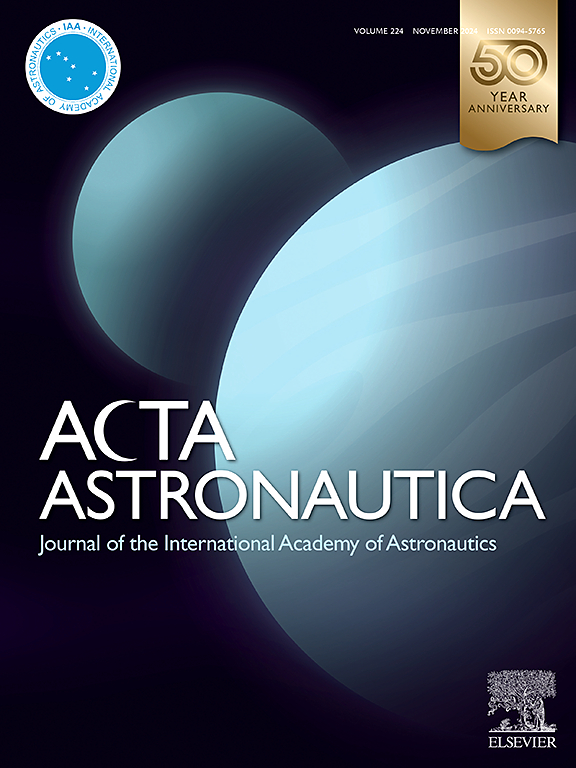The sputtering-deposition balance in the beam and backflow regions of electric propulsion plume
IF 3.4
2区 物理与天体物理
Q1 ENGINEERING, AEROSPACE
引用次数: 0
Abstract
This paper investigates the sputtering and deposition effects in the backflow and beam regions under the influence of plasma flow in a Krypton propellant Hall thruster. Quartz crystal microbalance measurements were used to study deposition and sputtering in both the beam and backflow regions. The experimental results show that the plasma density in the backflow region is approximately on the order of 1014m−3, with a spatial potential ranging from 9.7 V to 13.8 V. The backflow region is predominantly characterized by low-energy ions generated by the charge-exchange effect. Additionally, the ion energy in the backflow region is more sensitive to the anode voltage. The results indicate that the backflow region is mainly dominated by the deposition of contaminants, while the beam region exhibits a combined effect of high-energy ion sputtering and the deposition of erosion products. The deposition rate in the backflow region increases with the propellant flow rate, showing consistency with the plasma density. The deposited products include B, C, N, and some metals, with deposition rates and spatial distributions of the primary products derived from frequency calibration. The sputtering mass fraction within the divergence half-angle accounts for 87.7 % of the total sputtering, and the sputtering effect is influenced by both the anode voltage and propellant flow rate. Higher anode voltage helps reduce the sputtering range of high-energy beams. It was found that the actual deposition amount is at least 4.7 times greater than the measured deposition. The new model considers the deposition of products from the thruster and secondary sputtering, allowing for a qualitative analysis of the actual deposition values based on the ion energy and the results from the energy dispersive spectrometer.
电推进羽流光束区和回流区的溅射-沉积平衡
本文研究了等离子体流对氪推进剂霍尔推进器回流区和束流区的溅射和沉积效应。用石英晶体微天平测量了光束和回流区的沉积和溅射。实验结果表明,回流区的等离子体密度约为1014m−3数量级,空间电位范围为9.7 ~ 13.8 V。回流区主要以电荷交换效应产生的低能离子为特征。此外,回流区的离子能量对阳极电压更为敏感。结果表明:回流区主要是污染物的沉积,而光束区则是高能离子溅射和侵蚀产物沉积的综合作用。回流区沉积速率随推进剂流量增大而增大,与等离子体密度一致。沉积产物包括B、C、N和一些金属,主要产物的沉积速率和空间分布由频率标定得到。发散半角内的溅射质量分数占总溅射质量分数的87.7%,溅射效果受阳极电压和推进剂流量的共同影响。较高的阳极电压有助于减小高能光束的溅射范围。研究发现,实际沉积量至少是测量沉积量的4.7倍。新模型考虑了推力器和二次溅射产生的沉积产物,可以根据离子能量和能量色散光谱仪的结果对实际沉积值进行定性分析。
本文章由计算机程序翻译,如有差异,请以英文原文为准。
求助全文
约1分钟内获得全文
求助全文
来源期刊

Acta Astronautica
工程技术-工程:宇航
CiteScore
7.20
自引率
22.90%
发文量
599
审稿时长
53 days
期刊介绍:
Acta Astronautica is sponsored by the International Academy of Astronautics. Content is based on original contributions in all fields of basic, engineering, life and social space sciences and of space technology related to:
The peaceful scientific exploration of space,
Its exploitation for human welfare and progress,
Conception, design, development and operation of space-borne and Earth-based systems,
In addition to regular issues, the journal publishes selected proceedings of the annual International Astronautical Congress (IAC), transactions of the IAA and special issues on topics of current interest, such as microgravity, space station technology, geostationary orbits, and space economics. Other subject areas include satellite technology, space transportation and communications, space energy, power and propulsion, astrodynamics, extraterrestrial intelligence and Earth observations.
 求助内容:
求助内容: 应助结果提醒方式:
应助结果提醒方式:


